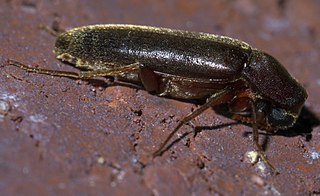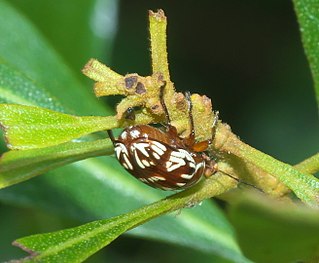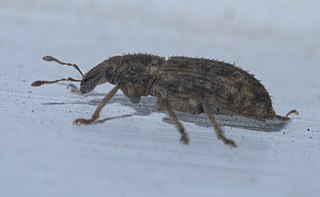
The rain beetles are a group of beetles whose extant species are found only in the far west of North America. They spend most of their lives underground, emerging in response to rain or snow, thus the common name. Formerly classified in the Scarabaeidae, they are currently assigned to their own family Pleocomidae, considered the sister group to all the remaining families of Scarabaeoidea. The family contains a single extant genus, Pleocoma, and two extinct genera, Cretocoma, described in 2002 from Late Cretaceous deposits in Mongolia, and Proteroscarabeus of Late Cretaceous China.

Pleocoma is the only extant genus of rain beetles and is endemic to the Pacific states of North America. Fossil remains of Pleocoma have been found in the Yixian Formation in China, suggesting beetles in this genus have existed in something like their present form since at least the Cretaceous period. There are 27 described species in Pleocoma.

Lema opulenta is a species of leaf beetle in the family Chrysomelidae. It is found in Central America and North America.

Melittomma sericeum, the chestnut timberworm, is a species of ship-timber beetle in the family Lymexylidae. It is found in North America.
Syneta ferruginea, the rusty leaf beetle, is a species of leaf beetle. It is found in eastern North America.
Phloeosinus punctatus, the western cedar bark beetle, is a species of crenulate bark beetle in the family Curculionidae. It is found in North America.
Ischalia costata is a species of broad-hipped flower beetle in the family Ischaliidae. It is found in North America.
Ptinus tumidus is a species of spider beetle in the family Ptinidae. It is found in North America.
Psiloscelis corrosa is a species of clown beetle in the family Histeridae. It is found in North America.
Optioservus heteroclitus is a species of riffle beetle in the family Elmidae. It is found in North America.

Bassareus brunnipes is a species of case-bearing leaf beetle in the family Chrysomelidae. It is found in North America.
Silvanus muticus is a species of silvanid flat bark beetle in the family Silvanidae. It is found in Central America and North America.
Cylloepus abnormis is a species of riffle beetle in the family Elmidae. It is found in Central America and North America.

Listronotus is a genus of underwater weevils in the family Curculionidae. There are at least 100 described species in Listronotus.
Nephus ornatus, the ornate lady beetle, is a species of dusky lady beetle in the family Coccinellidae. It is found in North America.
Pytho seidlitzi is a species of dead log beetle in the family Pythidae. It is found in North America.
Exochomus aethiops, the round black ladybug, is a species of lady beetle in the family Coccinellidae. It is found in Central America and North America.

Limnichidae, commonly called minute marsh-loving beetles, is a family of beetles belonging to Byrrhoidea. There are at least 30 genera and 350 described species in Limnichidae. They are found worldwide, with the greatest diversity in tropical regions. Most species seem to be associated with water-adjacent habitats, such as riparian and coastal locations, though many species are likely fully terrestrial, with some species being associated with leaf litter and arboreal habitats. Species with known diets feed on moss or algae. The oldest fossils of the family are known from mid-Cretaceous Burmese amber from Myanmar.
Dicerca lepida, the embossed hawthorn buprestid, is a species of metallic wood-boring beetle in the family Buprestidae. It is found in North America and varies in size between 13.5 and 17.5 millimetres.
Pleocoma rickseckeri is a species of rain beetle in the family Pleocomidae. It is found in North America. It was named in honor of Lucius Edgar Ricksecker.





